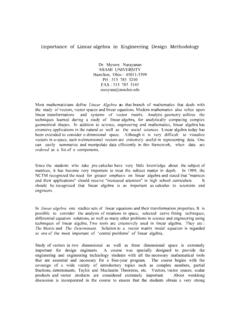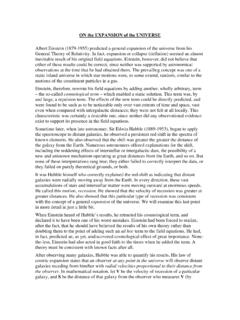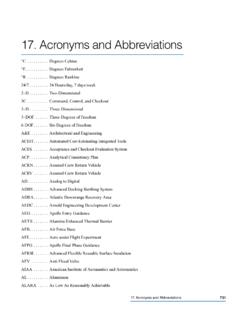Transcription of an d D at a H an d l i n g U n i t S c i e n c e In ... - NASA
1 Science Instrument Commandand Data Handling UnitThe SI C&DH unit keeps all scienceinstrument systems synchronized. Itworks with the DMU to process, formatand temporarily store information onthe data recorders or transmit scienceand engineering data to the ground. ComponentsThe SI C&DH unit is a collection of elec-tronic components attached to anOrbital Replacement Unit (ORU) traymounted on the door of Bay 10 in theSSM Equipment Section. Small remoteinterface units (RIU), also part of thesystem, provide the interface toindividual science instruments. Components of the SI C&DH unit are: NASA Standard Spacecraft Computer (NSCC-1) Two standard interface circuit boards for the computer Two control units/science data formatter units (CU/SDF) Two central processing unit (CPU) modules APCU Two RIUs Various memory, data and command communications lines (buses) con-nected by couplers.
2 These components are redundant sothe system can recover from any Computer. The original SI C&DHNSSC-1 has one CPU and eight memorymodules, each holding 8,192 eighteen-bit words. The replacement unit has oneCPU and four independent 64K memorymodules of Complementary Metal-Oxide Semiconductor (CMOS) memory -one memory module is usedoperationally, with the other threeserving as backups. An embeddedsoftware program (the executive ) runsthe computer. It moves data, commandsand operation programs (calledapplications) for individual scienceinstruments in and out of the processingunit.
3 The application programs monitorand control specific instruments, andanalyze and manipulate the memory stores operational com-mands for execution when thetelescope is not in contact with theground. Each memory unit has fiveareas reserved for commands andprograms unique to each scienceinstrument. The computer can bereprogrammed from the ground forfuture requests or for working aroundfailed with updates from the hubble Space telescope Servicing Mission 4 Media Reference Guide, 2009 Standard Interface Board. The circuitboard is the communications bridgebetween the computer and the Unit/Science Data heart of the SI C&DH unit is theCU/SDF.
4 It formats and sends allcommands and data to designateddestinations such as the DMU of theSSM, the NASA computer and thescience instruments. The unit has amicroprocessor for control andformatting above: Engineers in Goddard's large clean room prepare the flight spare Science InstrumentControl & Data Handling unit, known as SIC&DH 2, for electrical performance Credit: NASA/Chris GunnThe CU/SDF receives ground commands,data requests, science and engineeringdata, and system signals. Two examplesof system signals are time tags clocksignals that synchronize the entirespacecraft and processor interfacetables communications codes.
5 TheCU/SDF transmits commands andrequests after formatting them so thatthe specific destination unit can readthem. For example, ground commandsand SSM commands are transmittedwith differ- ent formats because groundcommands use 27-bit words and SSMcommands use 16-bit Control Unit. The PCUdistributes and switches power amongcomponents of the SI C&DH unit. It alsoconditions the power required by eachunit. For example, the computermemory boards typically need +5 volts,-5 volts and +12 volts while the CU/SDFrequires +28 volts. The PCU ensures thatall voltage requirements are Interface Unit.
6 RIUs transmitcommands, clock and other systemsignals, and engineering data betweenthe science instruments and the SIC&DH unit. However, the RIUs do notsend science data. There are six RIUs inthe telescope : five attached to thescience instruments and one dedicatedto the CU/SDF and PCUs in the SI C&DHunit. Each RIU can be coupled with up totwo expander units. The formatter translates each commandsignal into a common format. TheCU/SDF also reformats and sendsengineering and science data. Onboardanalysis of the data is an NSSC-1function. Communications Buses. The SI C&DHunit contains data bus lines that passsignals and data between the unit andthe science instruments.
7 Each bus ismultiplexed: one line sends system mes-sages, commands and engineering datarequests to the module units, and areply line transmits requestedinformation and science data back tothe SI C&DH unit. A coupler attaches thebus to each remote unit. This isolatesthe module if the RIU fails. The SI C&DHcoupler unit is on the ORU SI C&DH unit handles science instru-ment system monitoring (such as timingand system checks), commandprocessing and data Monitoring. Engineering datatell the monitoring computer whetherinstrument systems are functioning. Atregular intervals, varying from every 500milliseconds to every 40 seconds, the SIC&DH unit scans all monitoring devicesfor engineering data and passes data tothe NSCC-1 or SSM computer.
8 Thecomputers process or store theinformation. Any failure indicated bythese constant tests could initiate a safing hold situation and thus asuspension of science operations. Command Processing. Figure 5-27shows the flow of commands within theSI C&DH unit. Commands enter theCU/SDF (bottom right in the drawing)through the SSM Command DIU (groundcommands) or the DIU (SSMcommands). The CU/SDF checks andreformats the commands, which then goeither to the RIUs or to the NSCC-1 forstorage. Time-tagged commands, storedin the computer s memory (top right ofdrawing), also follow this process.
9 Each command is interpreted as realtime, as if the SI C&DH just received commands actually are onboardstored commands activated by certainsituations. For example, when the tele-scope is positioned for a programmedobservation using the Cosmic OriginsSpectrograph, that program is SI C&DH can issue certain requeststo the SSM, such as to execute a limitednumber of pointing control functions tomake small telescope maneuvers. Science Data Processing. Science datacan come from all science instrumentsat once. The CU/SDF transfers incom-ing data through computer memorylocations called packet buffers.
10 It fillseach buffer in order, switching amongthem as the buffers fill and empty. Eachdata packet goes from the buffer to theNSCC-1 for further processing, ordirectly to the SSM for storage in thedata recorders or transmission to theground. Data return to the CU/SDF aftercomputer processing. Whentransmitting, the CU/SDF must send acontinuous stream of data, either fullpacket buffers or empty buffers calledfiller packets, to maintain asynchronized link with the SSM. Specialchecking codes (Reed-Solomon andpseudo-random noise) can be added tothe data as options. Figure 5-28 showsthe flow of science data in the telescope .












